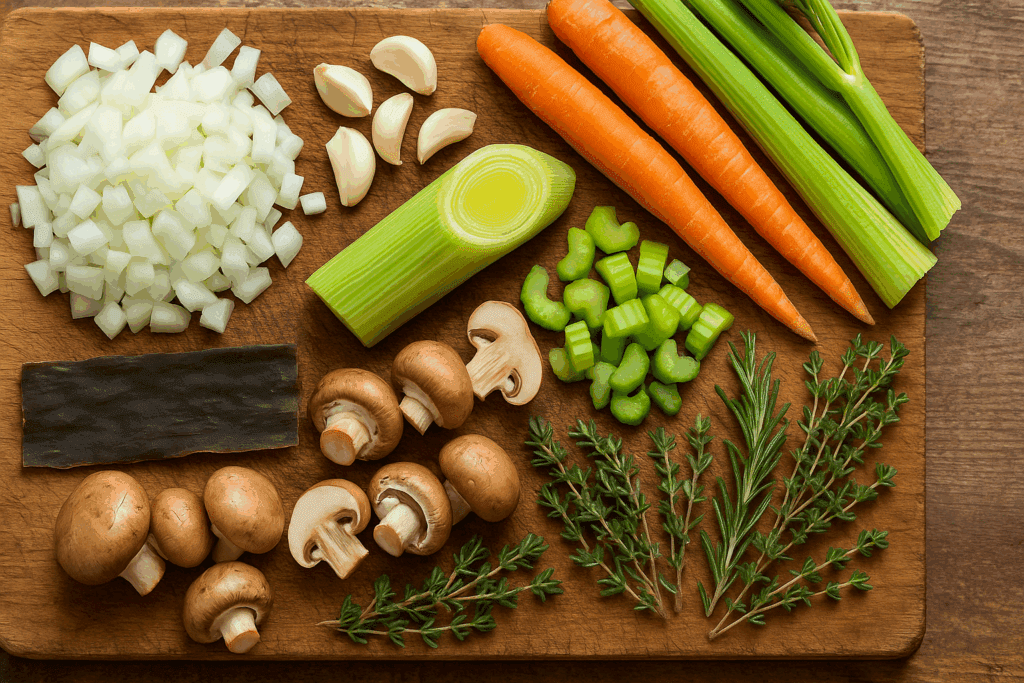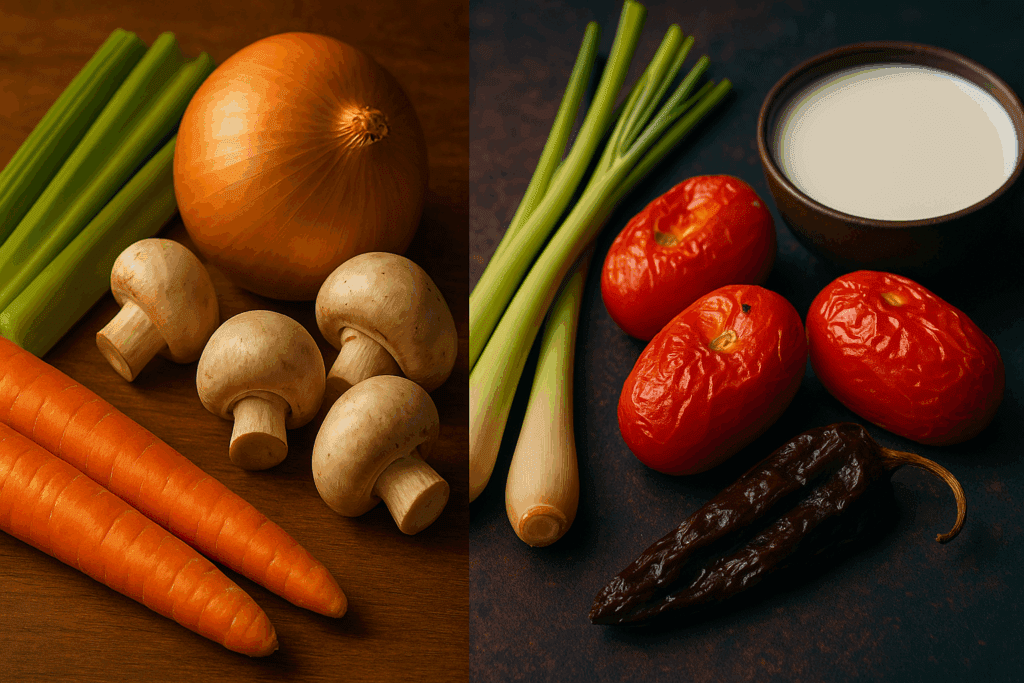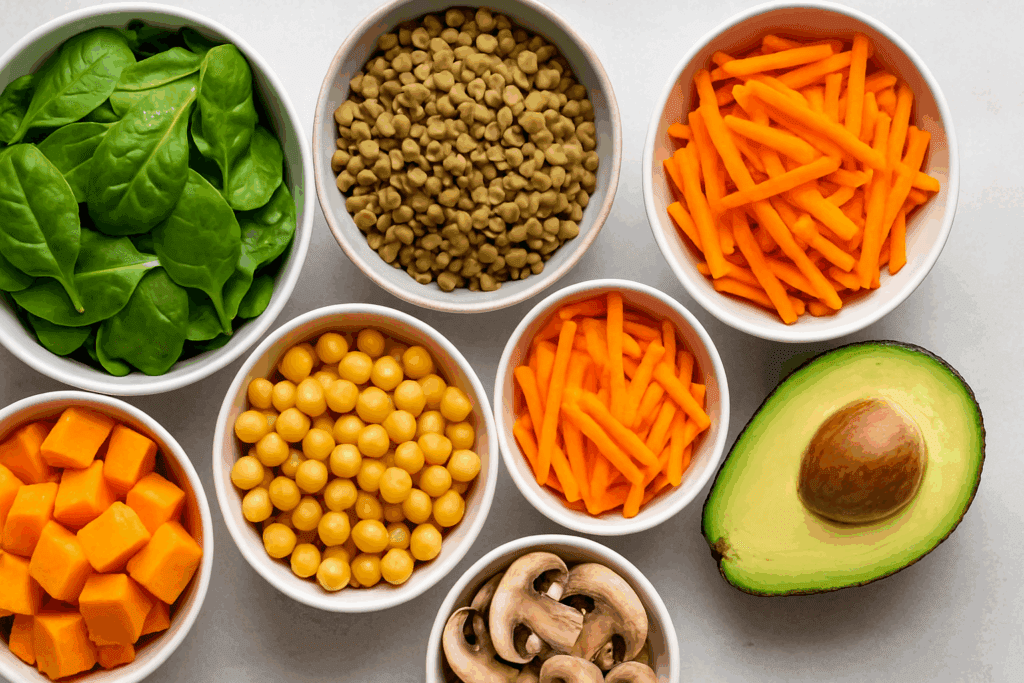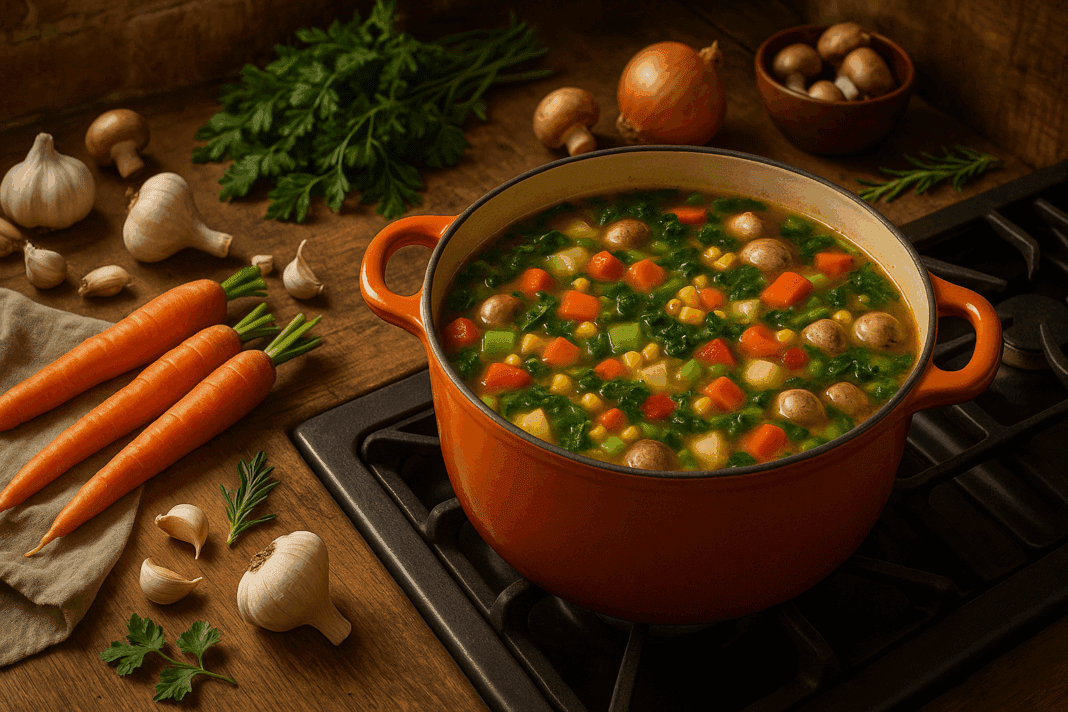Introduction: The Art and Science of Crafting a Vegan Soup Base
Soup has long held a special place in cultures across the world as a nourishing, comforting dish. In plant-based cooking, the foundation of any good soup lies in the vegan soup base, which defines its aroma, depth, and nutritional value. Whether you are an experienced vegan chef or new to the lifestyle, understanding how to develop a robust vegan soup base is key to crafting meals that are both satisfying and nutritionally balanced. As more individuals move toward plant-based eating for health, ethical, and environmental reasons, mastering this culinary skill becomes not just desirable but essential. A thoughtfully crafted vegan soup base can transform even the most modest ingredients into a gourmet experience, making plant-based nutrition accessible, affordable, and delectable.
You may also like: Healthy Plant-Based Dinners Made Easy: Best Whole Food Plant-Based Recipes for Beginners and Beyond
At its core, a vegan soup base is about layering flavors, balancing nutrition, and enhancing the natural tastes of vegetables, herbs, and spices. While many traditional soup bases rely on animal products such as chicken stock or bone broth, plant-based alternatives can be just as rich and complex when prepared with intention. This article explores the science behind a perfect vegan soup base, delves into tried-and-true vegan soup base recipes, and provides insights into the healthiest and most flavorful ways to build a hearty, comforting soup from scratch.
Why a Good Vegan Soup Base Matters for Health and Flavor
A vegan soup base is more than just a liquid medium; it is the canvas upon which all other flavors are painted. A properly constructed vegan soup base can add depth, complexity, and richness without the need for animal fats or processed additives. From a nutritional perspective, it provides an opportunity to incorporate nutrient-dense ingredients such as seaweed, root vegetables, mushrooms, and legumes, all of which contribute essential vitamins, minerals, and antioxidants.
Moreover, a well-made vegan soup base offers a low-calorie, high-satiety option that supports weight management, digestive health, and cardiovascular function. Many traditional stocks are high in saturated fat and sodium, but a vegan soup base crafted with fresh, whole foods can provide all the flavor with none of the health compromises. In the broader context of mindful eating and nutrition, investing time and care into creating a quality soup base aligns perfectly with the principles of intentional, health-focused cooking.

Key Ingredients That Elevate a Vegan Soup Base
Building a flavorful vegan soup base begins with selecting high-quality ingredients that can impart maximum flavor and nutrition. Aromatics like onions, garlic, and leeks form the backbone of most bases, offering a savory, umami-rich start. Carrots and celery add sweetness and complexity, while earthy mushrooms provide an additional depth that mimics the richness of traditional meat-based broths.
Seasonings play a pivotal role as well. Bay leaves, thyme, rosemary, and sage can infuse the base with herbaceous notes, while spices like cumin, coriander, and turmeric introduce warmth and global flair. Sea vegetables such as kombu can enhance the mineral content and provide subtle umami flavor, often associated with traditional Japanese broths. Tomatoes, either fresh or in paste form, can also add acidity and brightness, helping to balance richer flavors.
Another vital element of a great vegan soup base is the inclusion of umami-boosting ingredients. Nutritional yeast, miso paste, and tamari can all contribute layers of savory complexity that deepen the overall flavor profile without resorting to animal products. Properly balancing these components ensures that each spoonful is rich, satisfying, and nutritionally robust.

Techniques for Building Flavor in a Vegan Soup Base
Technique is as important as ingredient selection when crafting a vegan soup base. One essential technique is sweating the aromatics. Slowly cooking onions, garlic, and other base vegetables over low heat helps to release their natural sugars, resulting in a sweeter, more complex flavor profile. Adding a pinch of salt early in this process can help draw out moisture and intensify flavors.
Deglazing the pot is another key step. After sautéing the vegetables, adding a small amount of wine, vegetable broth, or even water can lift the caramelized bits from the bottom of the pot, incorporating them back into the base for added depth. Layering flavors gradually—rather than adding everything at once—allows each ingredient to shine while contributing to the cohesive whole.
Simmering, rather than boiling, the base ensures that the delicate flavors of herbs and vegetables are preserved. A gentle simmer helps to extract flavor without causing bitterness or degradation of nutrients. Skimming off any foam or impurities that rise to the surface during this process also results in a cleaner, more refined soup base.
Easy Vegan Soup Base Recipe: A Foundation for Countless Creations
Creating a basic vegan soup base recipe that can be adapted for various cuisines and dishes is a valuable tool in any cook’s repertoire. A classic starter involves sautéing diced onions, carrots, and celery in a small amount of olive oil until tender. Adding minced garlic, a bay leaf, and a sprig of thyme enhances the aromatic quality. Once the vegetables are softened, water or vegetable broth is introduced, and the mixture is gently simmered for 30 to 45 minutes.
This versatile vegan soup base recipe can serve as the starting point for countless soups, stews, and even sauces. For added richness, mushrooms, seaweed, or a spoonful of miso paste can be incorporated during the simmering process. A finishing touch of nutritional yeast provides a subtle cheesy flavor that further elevates the dish without overshadowing its delicate balance.
This simple yet powerful approach to crafting a vegan soup base allows for endless creativity, encouraging cooks to adapt the recipe to suit different flavor profiles, seasonal vegetables, and personal preferences. It also ensures that home cooks can consistently produce nutritious, delicious meals with minimal effort and maximum satisfaction.

Innovative Twists on the Traditional Vegan Soup Base
While a classic vegan soup base recipe forms the foundation of many dishes, exploring innovative twists can keep plant-based cooking exciting and satisfying. For example, roasting vegetables before simmering them can impart a deeper, caramelized flavor to the base. Roasted tomatoes, onions, and garlic, when blended into the soup base, create a luxurious texture and a naturally sweet taste that pairs well with Mediterranean-inspired dishes.
Incorporating global ingredients can also breathe new life into the vegan soup base. Adding lemongrass, ginger, and lime leaves results in a bright, fragrant broth reminiscent of Thai soups, while using chipotle peppers, cumin, and cilantro steers the base toward Latin American flavors. Coconut milk can lend a creamy, tropical element, ideal for creating rich, comforting soups without dairy.
Fermented ingredients like kimchi or sauerkraut juice can introduce probiotics and a tangy complexity that elevates the base to new heights. Such innovations not only keep plant-based meals interesting but also contribute additional nutritional benefits, further aligning with the goals of mindful eating and a healthier lifestyle.

Nutritional Considerations When Crafting a Vegan Soup Base
Beyond flavor, a thoughtfully crafted vegan soup base can significantly enhance the nutritional profile of a meal. Including a wide variety of vegetables ensures a broad spectrum of vitamins, minerals, and phytonutrients. Carrots provide beta-carotene, leafy greens offer iron and calcium, and mushrooms contribute vitamin D precursors and powerful antioxidants.
Balancing macronutrients is another important consideration. Adding legumes like lentils or chickpeas to the base can increase the protein content, making the soup more satisfying and supportive of muscle maintenance and energy levels. Including healthy fats from ingredients like olive oil, avocado, or coconut milk can enhance nutrient absorption and promote satiety.
Minimizing added sodium is crucial for maintaining heart health. Relying on herbs, spices, and naturally salty ingredients like miso or tamari—rather than excessive salt—ensures that the vegan soup base remains flavorful without compromising health. This careful attention to nutritional balance exemplifies the principles of mindful eating and underscores the value of a plant-based lifestyle.
Common Mistakes to Avoid When Making a Vegan Soup Base
Even experienced cooks can fall into common traps when preparing a vegan soup base. One frequent mistake is overcrowding the pot, which can cause vegetables to steam rather than sauté, resulting in a less flavorful base. Ensuring enough space for the vegetables to caramelize properly is crucial for developing rich, complex flavors.
Another pitfall is failing to season gradually. Adding all the salt and spices at once can lead to uneven flavor distribution and a flat-tasting broth. Seasoning in layers, tasting frequently, and adjusting as needed ensures a well-rounded final product.
Overcooking delicate ingredients is another common issue. Herbs, for example, can become bitter if simmered too long. Adding tender herbs like parsley, basil, or cilantro toward the end of cooking preserves their bright flavors and maximizes their nutritional value. Avoiding these common mistakes enhances the quality of the vegan soup base and ensures consistently delicious results.
Expert Tips for Enhancing Your Vegan Soup Base
Professional chefs often use a few simple techniques to take their vegan soup bases to the next level. One such tip is the “double broth” method: creating a concentrated vegetable stock first and then using it to cook a second batch of vegetables, resulting in an incredibly rich and layered flavor.
Another expert trick involves using “umami bombs”—ingredients like sun-dried tomatoes, smoked paprika, or caramelized onions—to deepen the savory notes of the base. These elements can be added in small amounts to dramatically enhance the overall taste without overpowering the soup.
Finally, considering texture as well as flavor can elevate a vegan soup base. Blending part of the soup while leaving the rest chunky creates a pleasing contrast that enhances mouthfeel and satisfaction. With these expert insights, even home cooks can achieve restaurant-quality results when crafting a vegan soup base.

Frequently Asked Questions: Deepening Your Understanding of Vegan Soup Bases
1. How can a vegan soup base improve the depth of flavor in plant-based dishes?
A vegan soup base is essential for creating complex, layered flavors in plant-based cooking without relying on animal products. By using roasted vegetables, fermented ingredients, or slow-simmered seaweed, you can amplify umami and richness that many assume only come from meat-based broths. A thoughtfully designed vegan soup base recipe can also incorporate unconventional ingredients like miso paste, kombu, or smoked paprika to deepen the taste profile. These choices not only enhance flavor but also provide trace minerals, probiotics, and other nutritional benefits often missing from simpler broths. Exploring these layers of taste expands the versatility of a vegan soup base beyond traditional vegetable stock, allowing cooks to recreate global culinary experiences authentically.
2. What are emerging trends in crafting a modern vegan soup base?
One of the most exciting trends today is the focus on fermentation and aging when crafting a vegan soup base. Chefs are exploring how slow fermentation of vegetables, soybeans, and grains can create naturally occurring glutamates, leading to a richer, more savory broth. Another emerging practice is the infusion of plant-based broths with medicinal herbs and adaptogens, creating a vegan soup base recipe that offers both taste and functional health benefits. Cold-brewed broths, a trend inspired by cold-brew coffee techniques, are also gaining popularity for their subtle, nuanced flavors. These innovations signal a future where the vegan soup base is not only a flavor enhancer but a personalized, health-supportive element of daily meals.
3. What mistakes should be avoided when making a vegan soup base recipe?
One common mistake is rushing the caramelization process of vegetables, which is critical for building a robust vegan soup base. Another misstep is neglecting to use enough seasoning or acidity; without these, the broth can taste flat or bland. Avoid boiling ingredients too vigorously, as this can break down delicate flavors and cloud the soup unnecessarily. An overlooked tip is using ice-cold water when initially covering your roasted vegetables—this helps to extract more nuanced flavors over a slow simmer. Finally, relying solely on sweet vegetables without balancing them with bitter greens or umami-rich ingredients can lead to an overly sugary vegan soup base that lacks sophistication.
4. How can a vegan soup base recipe support gut health?
A carefully crafted vegan soup base can be a powerful tool for gut health when it includes fiber-rich and prebiotic ingredients. Using components like onions, leeks, garlic, and Jerusalem artichokes can help nourish beneficial gut bacteria while providing savory depth. Adding fermented miso or a splash of unpasteurized apple cider vinegar into your vegan soup base recipe just before serving preserves probiotic cultures that support digestion. Seaweed, a frequent addition in advanced vegan broths, provides soluble fiber and essential iodine for gut and thyroid function. Beyond flavor, a mindful vegan soup base can thus be a proactive way to integrate wellness into everyday meals without additional supplementation.
5. Can a vegan soup base be adapted for specific dietary needs?
Absolutely! One of the greatest strengths of a vegan soup base is its flexibility to fit nearly any dietary need. For a low-FODMAP diet, selecting vegetables like carrots, spinach, and zucchini while avoiding onions and garlic makes a gut-friendly broth. If you’re following a ketogenic diet, a vegan soup base recipe rich in fats from coconut cream or avocado oil infusions can be tailored to support ketosis. Allergy-conscious individuals can easily avoid common allergens like soy and nuts by carefully choosing ingredients. The adaptability of a vegan soup base allows you to customize nutrition without sacrificing depth of flavor, making it a valuable staple across diverse dietary landscapes.
6. What global cuisines offer inspiration for a unique vegan soup base recipe?
Global cuisines provide endless inspiration for crafting distinctive vegan soup bases. For instance, Japanese kombu dashi, traditionally made with seaweed and mushrooms, offers an elegant, umami-rich vegan soup base that highlights the purity of simple ingredients. In Ethiopia, niter kibbeh (spiced clarified butter) can be replaced with infused coconut oil to create a vegan soup base layered with warm spices like cardamom and fenugreek. Latin American traditions use tomato, cumin, and chili to create vibrantly flavored vegan broth foundations. Even Nordic traditions inspire the use of root vegetables and fresh herbs for a clean, earthy vegan soup base recipe. Drawing from these global practices enriches not just your palate but also your cultural appreciation of food.
7. How does the psychological aspect of comfort food relate to a vegan soup base?
The aroma and warmth of a vegan soup base evoke strong emotional responses tied to comfort and nostalgia. Research in food psychology shows that sensory cues like smell and warmth can trigger the release of oxytocin, a hormone associated with bonding and stress reduction. Creating a vegan soup base recipe that incorporates aromatic herbs like rosemary, sage, or thyme can enhance these comforting sensations even further. Additionally, offering a vegan version of classic soups (like “chicken” noodle or minestrone) allows individuals transitioning to plant-based diets to retain emotional food traditions. In this way, a vegan soup base doesn’t just nourish the body—it nurtures the soul.
8. What role does a vegan soup base play in food sustainability?
Choosing a vegan soup base significantly reduces the environmental footprint of meal preparation. Traditional meat-based broths require resource-intensive livestock farming, while a plant-based broth uses fewer natural resources like water and land. Additionally, a vegan soup base recipe often leverages parts of vegetables that would otherwise go to waste, like carrot tops, celery leaves, or onion skins, contributing to a zero-waste kitchen ethos. This approach not only minimizes food waste but also encourages consumers to think critically about the full life cycle of their ingredients. Adopting a vegan soup base into regular meal planning is a tangible, delicious step toward more sustainable eating practices.
9. How can homemade vegan soup bases outperform store-bought options?
Homemade vegan soup bases often far surpass store-bought versions in both flavor and nutritional quality. Commercial options sometimes contain high levels of sodium, preservatives, and artificial flavor enhancers, which can diminish the health value of the broth. A homemade vegan soup base recipe allows you to control every ingredient, ensuring freshness, purity, and alignment with your dietary goals. Additionally, experimenting with layers of roasted vegetables, aromatic spices, and specialty mushrooms can create a more complex and satisfying taste experience. By crafting your own vegan soup base, you elevate both the culinary quality and the holistic health profile of your meals.
10. What future innovations could reshape the way we think about vegan soup bases?
Future innovations in food science are poised to transform the vegan soup base landscape dramatically. Lab-grown flavor compounds, derived from plants through precision fermentation, are being developed to mimic the richness of traditional broths without animal inputs. Advances in dehydration technology also mean that highly nutrient-dense vegan soup base recipes can soon be available in lightweight, shelf-stable formats for convenience without sacrificing quality. Additionally, artificial intelligence is being used to design custom flavor profiles, allowing consumers to create personalized vegan soup base blends tailored to their health goals and taste preferences. These innovations promise a future where vegan soup bases are not just alternatives, but the gold standard for broth creation.

Conclusion: Elevating Everyday Meals with a Flavorful Vegan Soup Base
Mastering the art of creating a flavorful vegan soup base is an essential skill for anyone embracing a plant-based, healthier lifestyle. Whether you are crafting a hearty lentil stew, a vibrant vegetable bisque, or a light miso broth, the principles of building a rich, balanced vegan soup base remain the same. Thoughtful ingredient selection, careful layering of flavors, and mindful cooking techniques can transform simple vegetables into deeply satisfying meals that nourish both body and soul.
By incorporating diverse ingredients, respecting culinary traditions from around the world, and emphasizing both flavor and nutrition, you can create vegan soup bases that are not only delicious but also aligned with the best practices of mindful eating and health-focused cooking. As the foundation of countless meals, a robust vegan soup base empowers home cooks to create versatile, sustainable, and life-enhancing dishes that celebrate the full potential of plant-based cuisine. Whether you’re following a vegan diet or simply seeking to incorporate more whole foods into your meals, mastering the vegan soup base recipe is a rewarding journey toward culinary excellence and better health.

